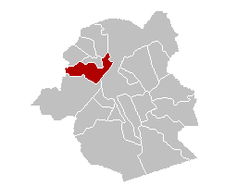Sint-Jans-Molenbeek
| Sint-Jans-Molenbeek (Dutch) Molenbeek-Saint-Jean (French) | |||
|---|---|---|---|
| Municipality of Belgium | |||
| |||
 Sint-Jans-Molenbeek (Dutch) Molenbeek-Saint-Jean (French) | |||
|
Map of Sint-Jans-Molenbeek (Dutch)
Molenbeek-Saint-Jean (French)
| |||
| Coordinates: 50°51′N 04°20′E / 50.850°N 4.333°ECoordinates: 50°51′N 04°20′E / 50.850°N 4.333°E | |||
| Country | Belgium | ||
| Community |
Flemish Community French Community | ||
| Region | Brussels | ||
| Arrondissement | Brussels | ||
| Government | |||
| • Mayor | Françoise Schepmans (MR) | ||
| Area | |||
| • Total | 5.89 km2 (2.27 sq mi) | ||
| Population (1 January 2012)[1] | |||
| • Total | 93,893 | ||
| • Density | 16,000/km2 (41,000/sq mi) | ||
| Postal codes | 1080 | ||
| Area codes | 02 | ||
| Website | www.molenbeek.irisnet.be | ||
Sint-Jans-Molenbeek (Dutch, pronounced [sɪnˈcɑnsˈmoːlə(n)ˌbeːk] (![]() )) or Molenbeek-Saint-Jean (French, pronounced [molənˈbek ˈsɛ̃ ʒɑ̃]) is one of the nineteen municipalities located in the Brussels-Capital Region of Belgium.
)) or Molenbeek-Saint-Jean (French, pronounced [molənˈbek ˈsɛ̃ ʒɑ̃]) is one of the nineteen municipalities located in the Brussels-Capital Region of Belgium.
History
Rural beginnings
The name Molenbeek comes from two Dutch words molen “mill” and beek “creek, beck”. Although first applied to the brook that ran through the village, the name eventually came to be used to designate the village itself around the year 985. In the early Middle Ages, Molenbeek was known for its miraculous well of Saint Gertrude, which attracted thousands of pilgrims.
The village was made part of Brussels in the 13th century. As a result, Molenbeek lost many of its lands to its more powerful neighbour. In addition, its main church was dismantled in 1578, leading to further decline. The town’s character remained mostly rural until the 18th century.
Industrialization
At the end of the 18th century, the Industrial Revolution and the building of the Brussels-Charleroi Canal brought prosperity back to Molenbeek, through commerce and manufacturing. In 1785, the city regained its status as an independent commune. Attracted by the industrial opportunities, many workers moved in, first from other Belgian provinces and France, then from South European, and more recently from East European and African countries. The growth of the community continued unabated throughout the 19th century, leading to cramped living conditions, especially near the canal.
The city became known as “Little Manchester” and its inhabitants lived through an extended period of misery. At the end of the 19th century, Brussels reintegrated the canal area within its new haven, which was thus lost to Molenbeek. The industrial decline, which had already started before World War I, accelerated after the Great Depression. In some areas of the city, the ensuing poverty left its mark on the urban landscape and scarred the social life of the community, leading to rising crime rates and pervading cultural intolerance. Various local revitalization programs are currently under way, aiming at relieving the most impoverished districts of the municipality.
Attempts at revitalizing the municipality have, however, not been successful. The multinational company BBDO in June, 2011 citing over 150 attacks on their staff by locals, posted an open letter to the mayor, Philippe Moureaux announcing their withdrawal from the town.[2] As a result, serious questions have been raised about governance, security, and the administration of Mayor Moureaux.[3]
Population
Muslim community
Over the past couple of decades, a substantial Muslim community of mainly Moroccan and Turkish ancestry has established itself in Molenbeek, very visible (people, shops, cafés) in the oldest neighbourhoods of the commune, near the canal, while the new neighbourhoods are more akin to the population of neighbouring communes Jette or Berchem-Sainte-Agathe. There are several mosques in the commune, including a Pakistani one, and a Shi'a Turkish mosque.[4]
Sights

- Several run-down industrial buildings have been renovated and converted into prime real estate and other community functions. Examples include the Raffinerie, a former sugar refinery that is now the site of a cultural and modern dance complex; the Fonderie, a former smelter that is now home to a labour and industry museum; the Bottelarij, a bottling plant which was housing the Royal Flemish Theatre during the renovation of the theatre in the centre of Brussels; and the most impressive Tour & Taxis building and surrounding area, which will be turned into various residences, as well as commercial enterprises.
- The Karreveld castle is used for a variety of cultural events, but also for the meetings of the municipal council.
- Regional nature park "Scheutbos".
- A brewery, the Brasserie de la Senne.
Famous inhabitants
- Toots Thielemans, jazz artist (b. 1922)
- Philippe Moureaux, politician, senator, mayor, and professor of economic history at the Université Libre de Bruxelles (b. 1939)
- Thierry Zéno, author-filmmaker (b. 1950)
- Zeynep Sever, Miss Belgium 2008
References
- ↑ Population per municipality on 1 January 2012 (XLS; 214 KB)
- ↑ "Insécurité à Molenbeek..." LaCapitale.be, 17 June 2012 and 27 August 2012.
- ↑ "BBDO zwaar ontgoocheld in Moureaux," De Standaard, 17 June 2011.
- ↑ "Mohammed-Ali association", Moniteur belge (in French) (Brussels: Kingdom of Belgium), April 24, 2004.
Twin cities
External links
| Wikimedia Commons has media related to Molenbeek-Saint-Jean. |
- Official site of Molenbeek-Saint-Jean (only in French or Dutch)
| ||||||||||||||||||||||||||



